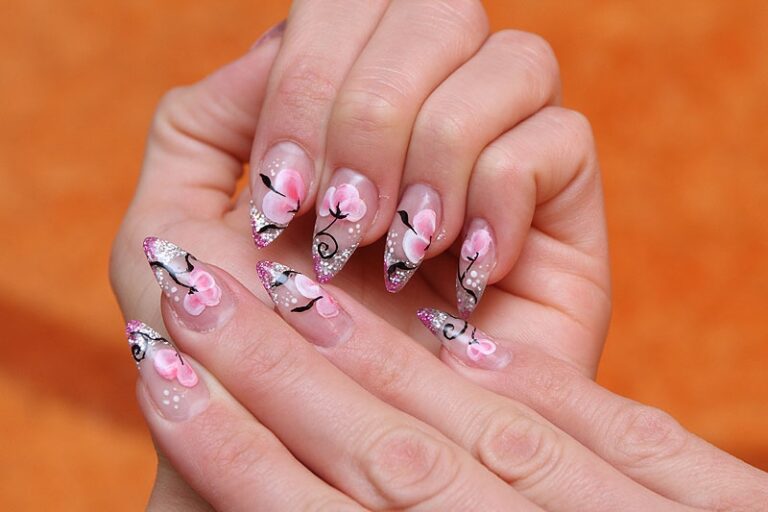“Roots of Growth: Where Nails Grow From”
Nails are a fascinating part of the human body, and understanding the factors that contribute to their growth is essential for maintaining healthy nails. In this article, we will explore the anatomy of nail growth, the nail growth cycle, the role of nutrition in nail health, and the impact of environmental factors on nail growth.
Key Takeaways
- The nail matrix is the primary site of nail growth and plays a crucial role in the production of new nail cells.
- Blood flow is essential for delivering nutrients to the nail matrix, supporting healthy nail growth.
- Factors such as age, genetics, and overall health can influence the rate of nail growth.
- The nail growth cycle consists of three phases: anagen, catagen, and telogen, each with distinct characteristics.
- Essential nutrients for nail growth include protein, biotin, and vitamins A, C, and E, which support the production of strong and healthy nails.
The Anatomy of Nail Growth

Understanding the Nail Matrix
At the core of nail growth is the nail matrix, a tissue located under the skin at the base of the nail. This is where new nail cells are generated, pushing the older cells forward and causing the nail to grow in length. The health and strength of the nail are largely determined by the condition of the matrix.
Proper care of the nail matrix is essential for maintaining nail health. Keeping the cuticles moisturized and avoiding trauma to the nail bed can prevent damage to the matrix. It’s also important to note that the matrix is sensitive to changes in the body’s health and can reflect nutritional deficiencies or systemic illnesses.
Remember: The nail matrix is the foundation of nail health. Treat it gently and pay attention to any changes in your nails, as they can be indicative of overall health issues.
The Role of Blood Flow
Blood flow plays a crucial role in nail growth, as it supplies the nail matrix with the necessary nutrients and oxygen. This process is vital for the production of new nail cells, which are formed in the matrix and gradually push the older cells forward, creating the visible part of the nail.
- Adequate blood circulation* is essential for healthy nail growth. Factors such as temperature, physical activity, and overall health can influence blood flow to the extremities, including the nail beds. For instance, colder temperatures can reduce blood circulation, potentially slowing nail growth.
To maintain optimal blood flow to the nails, consider the following tips:
- Keep your hands and feet warm, especially in cold environments.
- Engage in regular exercise to promote circulation.
- Avoid tight-fitting shoes and gloves that can constrict blood vessels.
Tip: Massaging the nail beds can also stimulate blood flow, which may aid in healthier and faster nail growth.
Factors Affecting Nail Growth
Factors such as nutrition, blood flow, and environmental conditions play a crucial role in determining the rate of nail growth. The availability of essential nutrients, particularly protein and biotin, is vital for promoting healthy nail growth. Additionally, adequate blood flow to the nail matrix ensures the delivery of nutrients and oxygen, supporting the growth process. Environmental factors, including climate and chemical exposure, can also impact the strength and resilience of nails, influencing their growth and overall health. It’s important to maintain a balanced diet and be mindful of environmental influences to support optimal nail growth and health.
Nail Growth Cycle

Anagen Phase
The anagen phase is the period of active growth for nails, akin to the foundation of a building where the initial structure is established. During this phase, cells in the nail matrix proliferate rapidly, contributing to the lengthening of the nail plate. This phase can last several years, and its duration is a key determinant in the maximum length that a nail can achieve.
Factors such as genetics, age, and hormonal balance play a crucial role in the anagen phase’s length and effectiveness. For instance, younger individuals typically experience a longer anagen phase, which contributes to faster and longer nail growth. Conversely, as we age, this phase may shorten, leading to slower nail growth.
Maintaining a balanced diet and proper nail care can optimize the health of your nails during the anagen phase, ensuring they grow strong and resilient.
Catagen Phase
Following the active growth in the anagen phase, the catagen phase marks a transitional period where nail growth slows down and the nail prepares to enter the resting phase. This phase is relatively short, typically lasting just a few weeks. During this time, the lower part of the nail stops dividing and begins to detach from the underlying nail bed.
- Metabolic processes decrease significantly as the nail enters a state of controlled regression. This phase is crucial for the renewal of the nail, as it allows for the eventual shedding of the old nail and the development of a new one. The following are key characteristics of the catagen phase:
- Decreased cell division
- Detachment of the nail from the nail bed
- Reduced metabolic activity
Remember: While the catagen phase is brief, it is essential for healthy nail renewal. Any disruption in this phase can affect the nail’s appearance and health.
Telogen Phase
Following the catagen phase, the telogen phase marks a period of rest for the nail. During this phase, which typically lasts for around three months, the nail does not actively grow. This is a natural part of the nail’s lifecycle, and it’s essential for the regeneration of the nail matrix. After this resting period, the nail will once again enter the anagen phase, where active growth resumes.
It’s important to note that external factors such as stress or trauma can prematurely trigger the telogen phase. This condition, known as telogen effluvium, can lead to noticeable changes in nail health and appearance. For instance, nails may become more brittle or develop ridges due to a disruption in the growth cycle.
Maintaining a balanced diet and managing stress are key to supporting the natural nail growth cycle and preventing premature entry into the telogen phase.
Nutrition and Nail Health

Essential Nutrients for Nail Growth
Nails require a variety of nutrients to grow strong and healthy. Among these, biotin, also known as vitamin B7, plays a pivotal role in the production of keratin, the protein that constitutes the majority of the nail. A deficiency in biotin can lead to brittle nails and slow growth.
Iron is another crucial nutrient; it helps in the transportation of oxygen to nail cells, promoting their growth. Vitamins A, C, D, and E are also important, as they contribute to the overall health of the nail bed and cuticle. For instance, vitamin C is essential for collagen production, which provides structural support to the nails.
Including omega-3 fatty acids in your diet can lead to stronger, shinier nails as these fats help to regulate oil production in the nail bed. Here’s a list of essential nutrients for nail growth:
- Biotin (Vitamin B7)
- Iron
- Vitamin A
- Vitamin C
- Vitamin D
- Vitamin E
- Omega-3 Fatty Acids
Tip: Consistently including these nutrients in your diet can improve not only your nail health but also the appearance of your skin and hair.
Impact of Diet on Nail Health
The health of your nails is significantly influenced by your dietary choices. A balanced diet rich in essential nutrients can lead to stronger, healthier nails, while deficiencies may result in brittleness or slow growth. Biotin, for instance, is a key vitamin for nail strength and vitality. Foods such as eggs, almonds, and whole grains are excellent sources of biotin and should be included in your diet for optimal nail health.
Consistency in your dietary habits is crucial for maintaining nail health. Sudden changes, like those experienced on a keto diet, can lead to varied effects on nail condition. It’s important to monitor how dietary shifts impact your nails and adjust accordingly.
Tip: To promote nail growth and prevent breakage, ensure your diet includes a mix of proteins, vitamins, and minerals. Regular intake of biotin-rich foods can be particularly beneficial.
Remember, while external nail care is important, internal nourishment is the foundation of nail health. Paying attention to what you eat can make a noticeable difference in the appearance and strength of your nails.
Environmental Factors

Effects of Climate on Nail Growth
Climate plays a significant role in the health and growth of nails. Low humidity in cold winter months can often affect nail health, leading to brittleness. On the other hand, excessive moisture from high humidity can also impact the strength and resilience of nails. It’s important to maintain a balanced level of moisture to promote healthy nail growth. Additionally, extreme temperatures, especially cold weather, can slow down the nail growth process. Proper climate control and regular moisturization are essential for maintaining optimal nail health and growth.
Chemical Exposure and Nail Health
Exposure to certain chemicals can significantly impact nail health, often leading to conditions such as brittleness, discoloration, and a slowed growth rate. Nail salon technicians, for instance, are routinely exposed to volatile organic compounds (VOCs) present in various nail products. These VOCs are not only harmful to the nails but may also pose serious health risks, including respiratory issues and even cancer.
It’s crucial to be aware of the ingredients in nail care products. Here’s a simple list to keep in mind when selecting safer options:
- Look for cruelty-free and vegan labels.
- Choose products that promote stronger nails.
- Opt for items that are free from harsh chemicals like formaldehyde and toluene.
Tip: Always wear protective gloves when using nail products that contain harsh chemicals to minimize direct exposure.
Individuals who frequent nail salons or perform home manicures should also consider the potential risks. Workplace hazards for nail care workers include not only chemicals but also dust, bacteria, viruses, and muscle strain from awkward positions. Making informed choices about the products you use can contribute to healthier nails and overall well-being.
When it comes to nail art design, environmental factors play a crucial role in determining the sustainability and eco-friendliness of the products and techniques used. At NAILinspire.com, we are committed to promoting environmentally conscious nail art practices that minimize the impact on the planet. From non-toxic nail polishes to eco-friendly nail art tools, we strive to provide a comprehensive online nail art design library that aligns with sustainable principles. Explore our collection of environmentally friendly nail art supplies and join us in creating a greener, more beautiful world.
Frequently Asked Questions
How do nails grow?
Nails grow from the nail matrix, a specialized group of cells at the base of the nail.
What role does blood flow play in nail growth?
Blood flow is essential for delivering nutrients and oxygen to the nail matrix, supporting the growth of healthy nails.
What factors can affect nail growth?
Various factors such as age, hormonal changes, and medical conditions can influence the rate of nail growth.
What is the nail growth cycle?
The nail growth cycle consists of three phases: anagen, catagen, and telogen, each with distinct characteristics.
How does diet impact nail health?
Consuming essential nutrients such as protein, biotin, and vitamins contributes to strong and healthy nails.
How does climate affect nail growth?
Climate can impact nail health, with factors like humidity and temperature influencing the condition of the nails.







